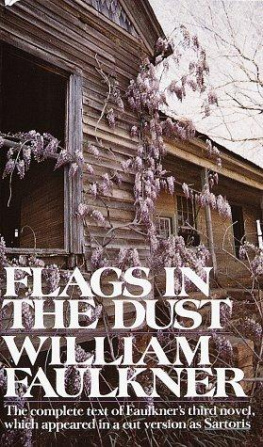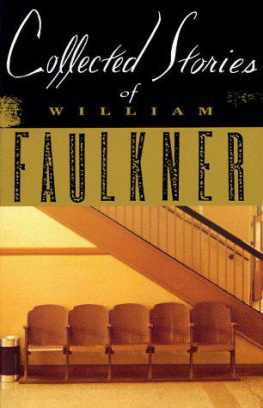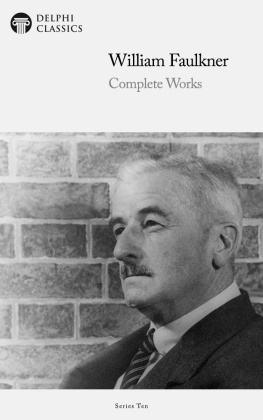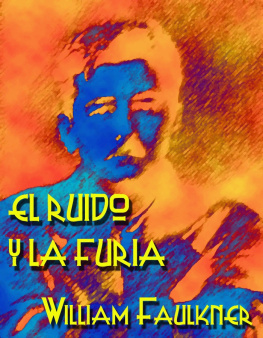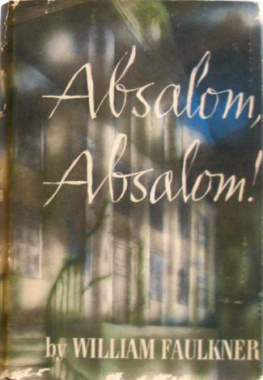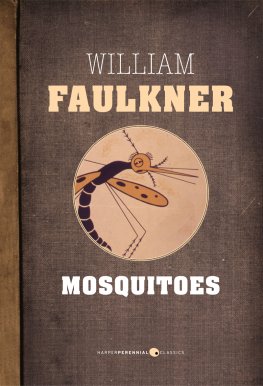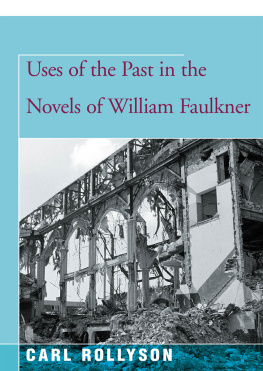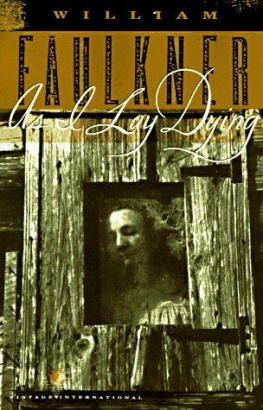William Faulkner - Flags in the Dust
Here you can read online William Faulkner - Flags in the Dust full text of the book (entire story) in english for free. Download pdf and epub, get meaning, cover and reviews about this ebook. year: 1974, publisher: Vintage, genre: Detective and thriller. Description of the work, (preface) as well as reviews are available. Best literature library LitArk.com created for fans of good reading and offers a wide selection of genres:
Romance novel
Science fiction
Adventure
Detective
Science
History
Home and family
Prose
Art
Politics
Computer
Non-fiction
Religion
Business
Children
Humor
Choose a favorite category and find really read worthwhile books. Enjoy immersion in the world of imagination, feel the emotions of the characters or learn something new for yourself, make an fascinating discovery.
- Book:Flags in the Dust
- Author:
- Publisher:Vintage
- Genre:
- Year:1974
- Rating:3 / 5
- Favourites:Add to favourites
- Your mark:
- 60
- 1
- 2
- 3
- 4
- 5
Flags in the Dust: summary, description and annotation
We offer to read an annotation, description, summary or preface (depends on what the author of the book "Flags in the Dust" wrote himself). If you haven't found the necessary information about the book — write in the comments, we will try to find it.
Flags in the Dust — read online for free the complete book (whole text) full work
Below is the text of the book, divided by pages. System saving the place of the last page read, allows you to conveniently read the book "Flags in the Dust" online for free, without having to search again every time where you left off. Put a bookmark, and you can go to the page where you finished reading at any time.
Font size:
Interval:
Bookmark:
,,,,,,,,,,,,,,,,,,,,,,,,,,,e t r ,,it nobody on the poch but,,,,,g ,,,,g p,g y,,,y,,p,,,,p,,,,,,ce, prodding at the blazing usket-barrel which stood in,,,trees far,g g,,,,,,ormer course, silently and utterly aler,,,ed. What would you do?,,,,,,,,,h a@page { margin-bottom: 5.000000pt; margin-top: 5.000000pt; }
William Faulkner
FLAGS IN THE DUST
(Edited as Sartoris )
73 (Restored, Uncut)
Introduction
In the autumn or winter of 1 26, William Faulkner, twenty-nine, began work on the first of his novels about Yoknapatawpha County. Sherwood Anderson had told him some time before that he should write about his native Mississippi, and now Faulkner took that advice: he used his own land, and peopled it with men and women who were partly drawn from real life, and partly depicted as they should have been in some ideal mythopoeic structure. A year later, on September 2 , 27, the new novel was completed. It was 5 6 pages long in transcript, and he called it Flags in the Dust. Full of enthusiasm, Faulkner sent Flags in the Dust up to Horace Liveright (who had published his first two novels) in New York. Liveright read it, disliked it, and sent it back with his firm recommendation that Faulkner not try to offer it for publication anywhere else: it was too diffuse, too lacking in plot and structure; and, Liveright felt, no amount of revision would be able to salvage it. Faulkner, crushed, showed Flags in the Dust to several of his friends, who shared Liveright s opinion.
But he still believed that this would be the book that would make his name as a writer, and for several months he tried to edit it himself, sitting at his work-table in Oxford. Finally, discouraged, he sent a new typescript off to Ben Wasson, his agent in New York.
Will you please try to sell this for me? he asked Wasson. I can t afford all the postage it s costing me. In the meantime, convinced that he would never become a successful novelist, Faulkner began work on a book that he was sure would never mean anything to anyone but himself: The Sound and the Fury.
Wasson tried eleven publishers, all of whom rejected Flags in the D ust . Finally he gave the typescript to Harrison Smith, then an editor of Harcourt, Brace & Company. Smith liked it, and showed it to Alfred Harcourt, who agreed to publish it, provided that someone other than Faulkner perform the extensive cutting job that Harcourt felt was necessary. For fifty dollars, Wasson agreed to pare down his client s novel. On September 20,1 28, Faulkner received a contract for the book, now to be called Sart o ris (no one knows who changed its name), which was to be about 100, 000 words long, and which was to be delivered to Harcourt; Brace sixteen days later. Faulkner left immediately for New York, presumably to help Wasson with his revision.
But when he sat down in Wasson s apartment to observe the operation on his novel, Faulkner found himself unable to participate. If it were cut, he felt, it would die. Wasson persisted, however, pointing out that the trouble with Flags in the Dust was that it was not one novel, but six, all struggling along simultaneously. This, to Faulkner, was praise: evidence of fecundity and fullness of vision, evidence that the world of Yoknapatawpha was rich enough to last. As he later wrote of his third novel, I discovered that my own little postage stamp of native soil was worth writing about and that I would never live long enough to exhaust it Nevertheless, Wasson kept Ms bargain with Alfred Harcourt. For the next two weeks, while Faulkner sat nearby writing The Sound and the Fury, Wasson went through the typescript of Flags in the Dust, making cuts of every sort until almost a fourth of the book had been excised. Harcourt, Brace published this truncated version on January 31, 1 , as Sartoris (with a dedication: To Sherwood Anderson through whose kindness I was first published, with the belief that this book will give him no reason to regret that fact ), and the old Flags in the Dust was soon forgottenby everyone but Faulkner.
He had preserved the original holograph manuscript of Flags in the Dust, 237 pages in his neat but minuscule and almost illegible hand; and he had bound together with thin wire the 5 6 pages of a sort of composite typescript of the novel, produced by the combination of three separate but overlapping typescript drafts. The first of these, 447 pages long, seems to have been begun before he completed his manuscript version. The second, pages of which are in the composite typescript, was probably written after he had completed the manuscript and the first typescript. In the third, 146 pages appear to have been a revision of the second typescript. Why Faulkner should have labored over the reconstruction of this text is not clear: perhaps he thought of his composite typescript as a working draft which would allow him ultimately to restore to his novel that which Wasson had carved from itor perhaps, fastidious man that he was, he simply could not bring himself to throw away all of those typed pages. In any case, the manuscript and typescript both were eventually deposited at the Alderman Library of the University of Virginia, where they lay more or less undisturbed until Mrs. Jill Summers, Faulkner s daughter, remembered that her late father had spoken often of a restoration of Flags in the Dust. Mrs. Summers asked this writer and Albert Erskine, editor at Random House, to undertake the task.
The result is, now, Flags in the Dust, which aims at being a faithful reproduction of that composite typescript. Certain nonsubstantive alterations in spelling and punctuation have been made, in order to bring this novel into conformity with Faulkner s other books; but wherever possible his many idiosyncrasies, especially those on which he himself insisted during his years of working with editors at Random House, were allowed to stand. The final complete typescript, which must have ser ved as setting copy for the Har court, Brace edition of Sartoris (and which must have been the draft in which Wasson made his cuts), has not survived, n or have any galley proofs. All we had to work from, then, was the composite typescript, by any scholar s standards a suspect source. There was no way, finally, to tell which of the many differences between Flags in the Dust and Sartoris were the result of Faulkner s emendations in the hypothetical setting copy and the galley proofs, and which belonged to Wasson. If there were to be any publication of Flags in the Dust at all, then, it had to be what we have here provided.
Whether it is better than Sartoris, as Faulkner so firmly believed it to be, is of course a matter of taste. It is tempting to launch into a study of the genesis and development of the novel, from the manuscript version through the typescript of Flags in the Dust to the publication of Sartoris; but this is not the place to do so. Suffice it here to suggest t that whereas Sartoris is chiefly about the Sartoris clan, their surly gallantry, and their utter and uncaring inability to adjust to the demands of whatever age they find themselves in, Flags in the Dust is far more complicated: primary focus is still on the Sartorises, but Faulkner clearly wished to make of his novel an anatomy of the entire Yoknapatawpha social structure, excluding only the Indians. As foils to the doomed and hawklike Bayard Sartoris, we have not only his dead twin, John, but Horace Benbow, too, as a sort of Delta dilettante; and Buddy MacCallum, the young hillman who possesses all the steady virtues Bayard lacks; Harry Mitchell, as the type of the new southern middle classand even Byron Snopes, the desperate and reptilian representative of a new class threatening to overthrow the old aristocratic order of the area. All of these are present in Sartoris, to be sure; but in Flags in the Dust their roles are lengthened and heightened, until we realize that each of them is in his way a commentary not only upon Bayard Sartoris, but also upon the Deep South in the years after the First World War.
Font size:
Interval:
Bookmark:
Similar books «Flags in the Dust»
Look at similar books to Flags in the Dust. We have selected literature similar in name and meaning in the hope of providing readers with more options to find new, interesting, not yet read works.
Discussion, reviews of the book Flags in the Dust and just readers' own opinions. Leave your comments, write what you think about the work, its meaning or the main characters. Specify what exactly you liked and what you didn't like, and why you think so.

